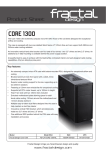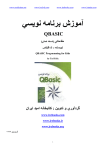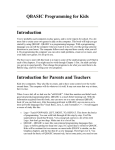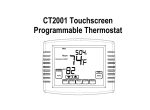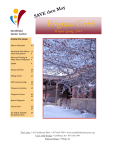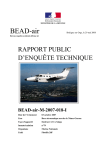Download 1991 SKELETAL STREET NETWORK FILE USER GUIDE
Transcript
1991 SKELETAL STREET NETWORK FILE USER GUIDE MapInfo® Format Produced by the Geography Division Statistics Canada AUGUST 1993 This User Guide contains an overview of the 1991 Skeletal Street Network Files (SSNFs), as well as a brief data quality statement. More details on the base files used to create the SSNFs can be obtained from the 1991 Street Network File User Guide. TABLE OF CONTENTS II.OVERVIEW OF THE SKELETAL STREET NETWORK FILE ............................................2 IV. DATA QUALITY STATEMENT ................................................................................................3 Lineage .....................................................................................................................................................3 Positional Accuracy................................................................................................................................4 Attribute Accuracy.................................................................................................................................4 2.4 Logical Consistency.............................................................................................................5 2.5Completeness......................................................................................................................................5 2.6Other Considerations........................................................................................................................5 VI.TECHNICAL SPECIFICATIONS (MapInfo®)...........................................................................6 4. GLOSSARY OF TERMS ...............................................................................................................7 5. SUPPLEMENTARY INFORMATION......................................................................................12 5.1 Related Geographic Products and Services ...................................................................12 5.2 For Further Information ..................................................................................................13 5.3 Additional References and Services ................................................................................15 Page 1 Statistics Canada 1991 Skeletal Street Network File - User Guide ARC/Info® is a registered trademark of the Environmental Systems Research Institute. MapInfo® is a registered trademark of Mapping Information Systems Corporation. Windows is a trademark of Microsoft Corporation. _____________________________________________________________________________ I.OVERVIEW OF THE SKELETAL STREET NETWORK FILE _____________________________________________________________________________ 1.Description Skeletal Street Network Files (SSNFs) are "thinned-out" street network files containing major roads and railways only (with street names but no address ranges). To define "major" streets, features forming census tract (CT) boundaries were used as a starting point. Where a street is identified as a CT boundary, effort was made to include its non-boundary extension for continuity. Shorelines or other water bodies are not included. Not all features forming CT boundaries were captured in the SSNFs. Census tract boundaries were used to define "major" streets within an urban centre for three reasons: -census tract boundaries tend to be major roads in a city; -the automation of the "thinning" process was made easier; and -this general concept was used to select major streets for the 1991 CMA/CA/CT reference maps. The attribute information associated with the streets include the street name, the type, and its direction where the direction is used within the street name identification (such as First Ave East). A Railway is identified with its name, such as CNR, THB (for the Toronto, Hamilton and Buffalo railway), etc. SSNFs are provided as a standard product in MapInfo® format in the Lambert Conformal Conic projection. They can also be ordered in ARC/Info Export format. They are line files with no polygon topology. Page 2 Statistics Canada 1991 Skeletal Street Network File - User Guide 2.Purpose The 1991 Skeletal Street Network Files contain a sub-set of streets and railways from the 1991 Street Network File. The SSNFs have been produced solely to provide some cartographic reference features when producing thematic maps with the CT Digital Cartographic Files (DCFs). The SSNFs do not contain shoreline features since shoreline is incorporated in the CT DCF. The SSNFs exist for areas covered by Street Network Files in all 25 census metropolitan areas (CMAs) and the 14 census agglomerations (CAs) which are included in the census tract program. The SSNFs are provided for users who do not require the detail of the Street Network Files from which they were derived. Page 2 Statistics Canada 1991 Skeletal Street Network File - User Guide _____________________________________________________________________________ III. DATA QUALITY STATEMENT _____________________________________________________________________________ The Skeletal Street Network Files were derived from the 1991 Street Network Files and the 1991 CT Digital Boundary Files. For a complete description of the SNF, refer to the 1991 Street Network File - User Guide, and the 1991 Digital Boundary File - User Guide for the Digital Boundary File description. 1.Lineage Lineage includes descriptions of the source material from which the data were derived and the methods of derivation, including the dates of the source material and all transformations involved in producing the final digital files or map products. Source Material The SSNFs were derived from the 1991 Street Network Files and the 1991 CT Digital Boundary Files as stated earlier. Refer to their respective user guides for a complete description of the lineage of those files. Method of Derivation The process of "thinning out" SNFs to create the SSNFs began by identifying those streets which were also CT boundaries by the following automated process: Working in an ARC/Info Version 6.0 environment, the CT Digital Boundary Files were overlaid on the 1991 SNFs in order to "flag" those arcs which formed a CT boundary. Since the CT DBFs were constructed using SNF features, a good match was ensured. Page 3 Statistics Canada 1991 Skeletal Street Network File - User Guide Using attribute information tables in ARC/Info, the arcs comprising portions of streets identified in the overlay process were identified by STREET NAME (e.g. First) and TYPE (e.g. Ave). These attributes were used to ensure the complete street was retrieved, and not just the portion of each street which constituted a CT boundary. This process retrieved all streets in the CMA or CA with the same STREET NAME and TYPE, thus some "non" CT boundary streets are included in the SSNF. In some cases, particularly in the larger urban centres, this process created a number of small unattached line segments (representing short streets or even highway ramps which have the same name as another street or ramp used elsewhere as a CT boundary within 2.1 Lineage - cont'd the CMA or CA). Every attempt was made to interactively remove these segments, though some may still remain in the files. Conversion to MapInfo® The MapInfo module ARCLINK was used to convert the resulting ARC/Info coverages into MapInfo format. 3.Positional Accuracy Positional accuracy is the difference between the "true" position of a feature in the real world and "estimated" position stored in the digital file. Positional accuracy depends on the quality of the source material used and the processes used to create the files (ie. manual drafting, digitizing etc.). No numerical measurements of positional accuracy have been made. SSNFs are designed to provide reference to the locations of the CT cartographic boundaries, and the line features in the SSNFs match the boundaries precisely. 5.Attribute Accuracy Attribute accuracy refers to the accuracy of the non-positional information contained in the digital file. Page 4 Statistics Canada 1991 Skeletal Street Network File - User Guide The attribute information contained in the file includes the feature NAME, TYPE and DIRECTION. Approximately 35 features within each of six of the 39 SSNFs were checked to ensure that the attribute information was transferred correctly from the corresponding Street Network Files. No errors were found. Note that the feature names as provided in the SSNFs may not match those precisely as depicted on the CMA/CA/CT Reference Maps. In some cases, alternate names are used (e.g. Road 30 is shown on the map, but called Innes Rd in the SSNF. Both names were shown on a street map of the same area). A few line segments in a SSNF may not have a name identified for them (For example, one such record in a total of 1535 records in the Halifax SSNF; three in 3699 records in the Hamilton SSNF - less than 0.1%). These blank records have no impact on the use for which the SSNFs were intended. 2.4 Logical Consistency Logical consistency describes the fidelity of relationships encoded in the data structure of the digital spatial data (ie. how well elements of the data structure follow the rules imposed on them). Some small unattached line segments may exist in the SSNFs as a result of the selection process from the SNF source files. These should have no impact on their use as a referential underlay for the CT DCFs for which the files were intended. 2.5Completeness Completeness expresses the degree to which the geographic entities (features) are captured according to the data capture specifications. It also contains information about selection criteria, definitions used and other relevant mapping rules. No verification was done to ensure that all streets that formed CT boundaries were included in the SSNFs since 100% completeness was not a rigid requirement for the purpose of these files. SSNFs do not exist for areas within the tracted CMA/CA not covered by Street Network Files. 2.6Other Considerations The SSNF will provide some context to the CT Digital Cartographic boundaries, in terms of street location, on a thematic map. Because CTs represent neighbourhoods, the bounding streets tend Page 5 Statistics Canada 1991 Skeletal Street Network File - User Guide to represent major or well known streets within any given city. These are meant to allow users to "orient" themselves when viewing a thematic map. The SSNF should not be used either to locate a street of interest (it may not be there), or as a definitive guide to major streets in a city (major streets are not always a CT boundary). _____________________________________________________________________________ V.TECHNICAL SPECIFICATIONS (MapInfo®) _____________________________________________________________________________ In MapInfo®, SSNFs are line files (as opposed to digital boundary files which are polygon files). Attribute information associated with each line segment: NAME: A twenty character code containing the given name of the feature. TYPE: A two character item used for street identification when the street is a single or multiple lane street. The TYPE is a unilingual abbreviation such as RD (Road), BV (Boulevard), HY (Highway), LI (Line), CH (Chemin), RL (Ruelle), AV (Avenue). DIRECTION: A two character code identifying the direction of the feature. The feature direction is not to be mistaken as being the geographic direction of a feature, but the direction used within the feature's identification. In most cases, this field is blank. The MapInfo® Table Structure is: NAMECharacter(20)indexed TYPECharacter(2) DIRECTION Character(2) Page 6 Statistics Canada 1991 Skeletal Street Network File - User Guide _____________________________________________________________________________ 4. GLOSSARY OF TERMS _____________________________________________________________________________ Address Range The low and high address (civic number). Boundary A line indicating the limit or extent of an area or territory. Census Agglomeration (CA)* The general concept of a census agglomeration (CA) is one of a large urban area, together with adjacent urban and rural areas which have a high degree of economic and social integration with that urban area. A CA is delineated around an urban area (called the urbanized core and having a population of at least 10,000, based on the previous census. Once a CA attains an urbanized core population of at least 100,000, based on the previous census, it becomes a census metropolitan area (CMA). Census Metropolitan Area (CMA)* The general concept of a census metropolitan area (CMA) is one of a very large urban area, together with adjacent urban and rural areas which have a high degree of economic and social integration with that urban area. Page 7 Statistics Canada 1991 Skeletal Street Network File - User Guide A CMA is delineated around an urban area (called the urbanized core and having a population of at least 100,000, based on the previous census). Once an area becomes a CMA, it is retained in the program even if its population subsequently declines. Census Tract (CT)* The general concept of a census tract (CT) is that of a permanent, small urban neighbourhood-like or rural community-like area established in large urban-centred regions with the help of local specialists interested in urban and social science research. * For the full definitions and additional remarks related to this term, users should refer to the 1991 Census Dictionary (Cat. No. 92-301E). Page 8 Statistics Canada 1991 Skeletal Street Network File - User Guide _____________________________________________________________________________ 4. GLOSSARY OF TERMS - CONT'D _____________________________________________________________________________ Census tracts are delineated jointly by a local committee and Statistics Canada according to the following criteria: (1)Whenever possible, census tract boundaries must follow permanent and easily recognizable physical features. (2)The population of a census tract must be between 2,500 and 8,000, with a preferred average of 4,000 persons, except for those census tracts in central business districts, in other major commercial and industrial zones, or in peripheral rural or urban areas that may have either a lower or higher population. (3)When first delineated, or subsequently subdivided, census tracts must be as homogeneous as possible in terms of the economic status and social living conditions of their populations. (4)Their shape must be as compact as possible. All census metropolitan areas (CMAs) and census agglomerations (CAs) in Canada containing a census subdivision (CSD), i.e. municipality, having a population of 50,000 or more at the previous census, are eligible for a census tract program. Once a census metropolitan area or census agglomeration is added to the program, it is retained even if the population subsequently decreases below 50,000. CSDs already within a tracted CMA do not qualify for a separate CT program when they reach a population of 50,000. Lambert Conformal Conic projection* A map projection which is widely used for mapping Canada on one sheet, since it provides good directional and shape relationships for mid-latitude regions having a mainly east-to-west extent. Standard parallels at 49° N and 77° N are most commonly used, as well as a central meridian at 91° 52° W. Locations are specified in easting and northing co-ordinates in metres relative to a pre-defined origin. Thematic maps* A thematic map is the representation of statistical data on a map. Thematic maps summarize statistical data, relate them to actual locations on the ground, and reveal geographic patterns or relationships. Thematic maps are used to portray spatial patterns of population income, etc. These maps are useful for policy and decision making or descriptive purposes. Page 9 Statistics Canada 1991 Skeletal Street Network File - User Guide * For the full definitions and additional remarks related to this term, users should refer to the 1991 Census Dictionary (Cat. No. 92-301E). Page 10 Statistics Canada 1991 Skeletal Street Network File - User Guide ____________________________________________________________________________ 4. GLOSSARY OF TERMS - CONT'D _____________________________________________________________________________ Feature An entity that will be included in the Street Network File. Railway A permanent way having rails which provide a track for train cars. Road Refer to Street. Shoreline The limit of a body of water where it touches land. In the SNF, the water body should, on average, be greater than 20 metres wide and indicated by shoreline rather than streamline. Street A thoroughfare within a city or town larger than an alley or lane. Page 11 Statistics Canada 1991 Skeletal Street Network File - User Guide ______________________________________________________________________________ 5. SUPPLEMENTARY INFORMATION ______________________________________________________________________________ 5.1 Related Geographic Products and Services The following is a summary of other geographic products and services available from Statistics Canada. CMA/CA/CT REFERENCE MAPS: These maps show the boundaries of CSDs, CMA/CA parts and CTs. Publications in the Census Tract Profile series contain corresponding maps for each tracted CMA or CA. DIGITAL BOUNDARY FILES: Digital Boundary Files are available for most levels of standard geography (from the enumeration area up to the province and territory). In combination with the user's appropriate software, these files provide the user with a spatial analytical tool for designing their own geographical areas (by aggregating standard geographical areas), for mapping, and for other data manipulation operations and analysis offered by the user's software. DIGITAL CARTOGRAPHIC FILE: The Digital Cartographic Files are geographic boundary files for thematic mapping applications used by Geographic Information Systems and mapping software packages. STREET NETWORK FILE: These computer files provide the street network for most large urban centres in Canada. They include streets, railways and other features, as well as relevant information such as street names and address ranges. Street Network Files are used as the base for a user's geographic application software for mapping purposes or special applications such as transportation planning or delivery services. The user should be aware of the vintages of the individual Street Network Files when considering the particular application. Page 12 Statistics Canada 1991 Skeletal Street Network File - User Guide 5.2 For Further Information For further information on the Skeletal Street Network Files or other products and services available from the Geography division, contact your nearest Regional Reference Centre. If you live outside the local dialing area, call one of the toll free numbers provided in the list that follows: Suite 412, East Tower ATLANTIC REGION NATIONAL CAPITAL REGION MONTRÉAL, Québec Statistical Reference Centre (NCR) Serving the provinces of H2Z 1X4 Newfoundland and Labrador, Nova Scotia, Prince Edward Island and New Brunswick. Toll free service: 1-800-361-2831 R.H. Coats Building Lobby Local calls: (514) 283-5725 Holland Avenue Fax number: (514) 283-9350 OTTAWA, Ontario Advisory Services Statistics Canada Statistics Canada K1A 0T6 Viking Building, 3rd Floor Crosbie Road If outside the local calling area, please ST. JOHN'S, Newfoundland dial the toll free number for your region. A1B 3P2 Local calls: (613) 951-8116 Fax number: (613) 951-0581 Toll free service: 1-800-565-7192 Fax Number: (709) 772-6433 ONTARIO REGION Advisory Services Advisory Services Statistics Canada Statistics Canada North American Life Centre Arthur Meighen Building, 10th Floor 1770 Market Street 25 St. Clair Avenue East HALIFAX, Nova Scotia TORONTO, Ontario B3J 3M3 M4T 1M4 Toll free service: 1-800-565-7192 Toll free service: Local calls: (902) 426-5331 Local calls: (416) 973-6586 Fax number: (902) 426-9538 Fax number: (416) 973-7475 QUÉBEC REGION 1-800-263-1136 PACIFIC REGION Advisory Services Statistics Canada Serving the province of British Columbia 200 René Lévesque Blvd. W. and the Yukon Territory. Guy Favreau Complex Page 13 Statistics Canada 1991 Skeletal Street Network File - User Guide Advisory Services PRAIRIE REGION Statistics Canada Sinclair Centre, Suite 300 Serving the provinces of 757 West Hastings Street Manitoba, Saskatchewan, Alberta VANCOUVER, B.C. and the Northwest Territories. V6C 3C9 Advisory Services Toll free service: 1-800-663-1551 Statistics Canada Local calls: (604) 666-3691 MacDonald Building, Suite 300 Fax number: (604) 666-4863 344 Edmonton Street WINNIPEG, Manitoba R3B 3L9 Toll free service: 1-800-563-7828 Local calls: (204) 983-4020 Fax number: (204)983-7543 Advisory Services Statistics Canada Avord Tower, 9th Floor 2002 Victoria Avenue REGINA, Saskatchewan S4P 0R7 Toll free service: 1-800-563-7828 Local Calls: (306) 780-5405 Fax Number: (306) 780-5403 Advisory Services Statistics Canada First Street Plaza, Room 401 138 - 4th Avenue South East CALGARY, Alberta T2G 4Z6 Toll free service: 1-800-563-7828 Local Calls: (403) 292-6717 Fax Number: (403) 292-4958 Advisory Services Statistics Canada Park Square, 8th Floor 10001 Bellamy Hill EDMONTON, Alberta T5J 3B6 Toll free service: 1-800-563-7828 Local Calls: (403) 495-3027 Fax Number: (403) 495-5318 Telecommunications Device for the Hearing Impaired 1-800-363-7629 Page 14 Statistics Canada 1991 Skeletal Street Network File - User Guide Toll Free Order Only Line (Canada and United States) 1-800-267-6677 5.3 Additional References and Services In addition to the Regional Reference Centres and depository libraries, Statistics Canada publications may be ordered through your local bookstore or subscription agent. Contact the nearest Regional Reference Centre for a list of Canadian outlets available, or consult the 1991 Census Catalogue (Catalogue No. 92-302E). Secondary distributors offer data access and analytical support through a variety of consulting and computer-based services not available at Statistics Canada. The names and addresses of licensed distributors may be obtained from any Regional Reference Centre. Statistics Canada provides digital geographic products which allow computer manipulation of geographic data. A customized retrieval service is available for users who wish to define their own geographic area of study. A variety of data retrieval files and services provide flexibility in selecting a geographic base. A complete description of available digital files and services is documented in the 1991 Census Catalogue (Catalogue No. 92-302E). Information concerning Census of agriculture products and services may be referenced in the 1991 Census of Agriculture Products and Services publication, Catalogue No. 92-303, or by calling toll free 1-800-465-1991. Users with special data requirements may request post-census survey services. Data are made available on microcomputer diskettes for use with spreadsheet software, or on paper output. For additional information, please contact the nearest Regional Reference Centre. The Dissemination Division is responsible for CANSIM, Statistics Canada's computerized database network and information retrieval service. Users are provided with access to current and historical statistics in various forms including specialized data manipulation and analysis packages, graphics facilities and a bibliographic search service. For more information about CANSIM, contact any Regional Reference Centre. Page 15 Statistics Canada 1991 Skeletal Street Network File - User Guide

















